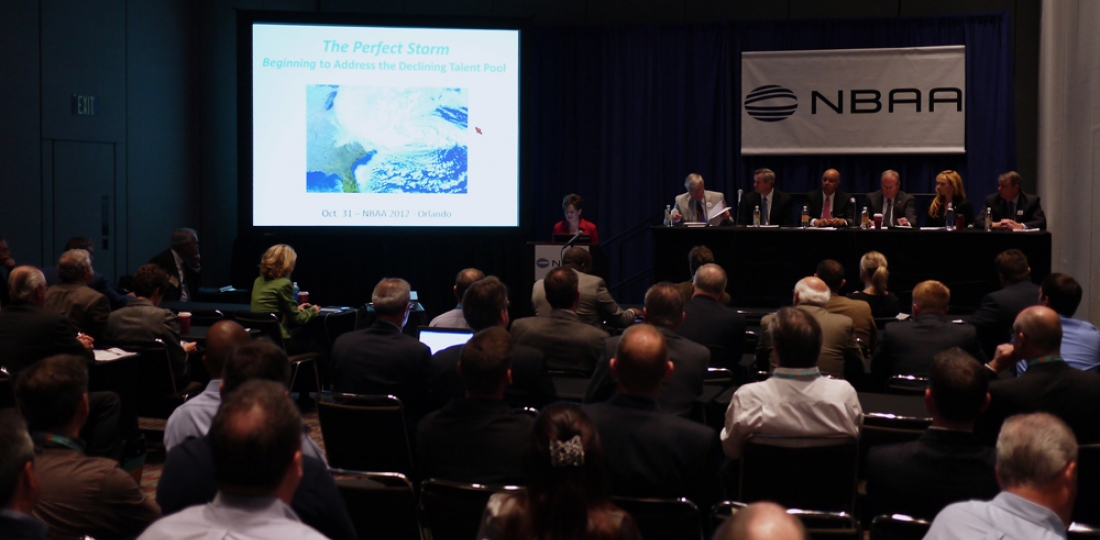As seen on the AINonline.com website.
The industry experts on the panel each postulated on the reasons why there is currently an imbalance in supply and demand.
Opening to a packed room at the NBAA Convention on Halloween eve is a feat in itself; to keep attendees’ attention for a full hour on such a busy day takes some meat. Sheryl Barden, president and CEO of Aviation Personnel International (API), moderated a panel of industry leaders who postulated their own theories for why we are currently forced to recruit aggressively to increase the pool of talented people from which to choose our next generation of aviators and aviation support staff throughout the world.
The panel was composed of Kevin Hiatt, COO of the Flight Safety Foundation; Guy Smith, past president of the University Aviation Association; Mark Malkosky, assistant director for maintenance business development with FlightSafety International; Dan Woodard, chief pilot for Conoco Phillips; Lonnie Robinson, chairman of Aviation Career Enrichment and a captain with US Airways; and Cassandra Shelby, past president of Women in Corporate Aviation and an international captain with Coca-Cola.
Barden opened the session with a quote from the chair of the Flight Safety Foundation. She said, “The future shortage of trained aviation professionals will be the greatest threat to aviation safety. But many say, after this recent downturn, ‘We’ve been hearing about this for years–it’s like Chicken Little.’” Yet competition for recruiting and selecting well-qualified aviation professionals is heating up, according to Barden. That stated, Barden picked her panelists’ brains with who, what, where, why and how questions on crafting solutions for flight and maintenance departments that are searching to replace experienced and soon-to-retire employees.
The industry experts on the panel each postulated on the reasons why there is currently an imbalance in supply and demand. Kevin Hiatt pointed out that the typical pilot graduating from a university aviation program has 300 to 500 hours of flight experience, whereas the typical 21-year-old college-educated male has an average of 17,000 hours of video/computer gaming experience by the end of his college career. And those are the students with the hand-eye coordination for the jobs in our industry. Airline pilots who would have retired at 60 are now reaching their “life limit” five years after the rule was enacted, and first officers with regional airlines will need an ATP beginning next year, so demand for qualified pilots is set to increase soon.
Guy Smith explained how students are being educated for and recruited into aviation by a team of 105 different colleges and universities, but he admitted to the group that these graduates are not typically qualified for the careers that are opening up. Worse, the ones who backed up their aviation aspirations with technical degrees, such as in computers or engineering or IT, are more likely to get high-paying jobs in those fields than in aviation–at least for the time being. Mark Malkosky backed him up about the issues that companies have recruiting talented, ethical and experienced maintenance personnel.
Conoco-Phillips’s Dan Woodard said his company is addressing its need for qualified relief pilots by creating an internship program. To date, the company has brought on one type-rated, low-time pilot for a test, and took him along as a “cruise pilot” on an around-the-world trip. Though he never took off or landed the airplane, he logged a whole lot of Gulfstream G550 time as second-in-command, and that, at his level of experience, is priceless. Woodard hopes that the internship program will become an affordable way for the flight department to “grow” new pilots for the company.
Lonnie Robinson and Cassandra Shelby touched on the benefits and, in this day and age, necessity of reaching out to populations that haven’t typically aspired to aviation careers, pointing out that raising awareness of the opportunities in aviation is key to increasing diversity in the industry.

